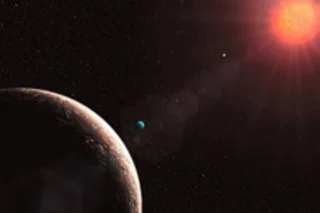Astronomers still haven't discovered Earth's twin orbiting another star out in the cosmos, but they're beginning to find worlds with a passing resemblance to our own. New studies of the red dwarf star Gliese 581 have revealed a small, rocky exoplanet with only twice the mass of Earth, and have also shed new light on a larger planet orbiting farther out, which researchers now say could have liquid water. Team member Stephane Udry believes that the larger planet could have
a "large and deep" ocean. "It is the first serious 'water-world' candidate," Udry said [AP].
Researchers had previously discovered three planets orbiting the star, including the potential water world, Gliese 581 d. Based on earlier observations, researchers thought that the planet took 83 days to orbit its star, which would indicate that the planet was too far from the red dwarf's weak heat to have liquid water. But more extensive ...














